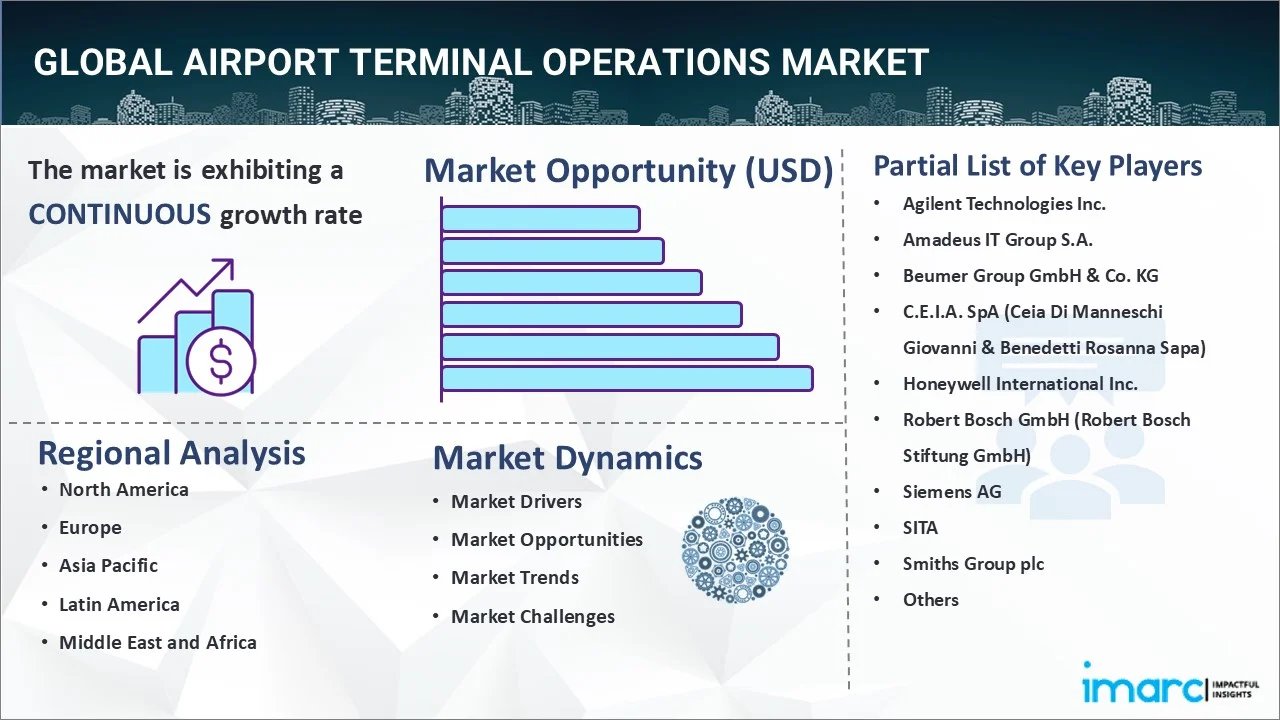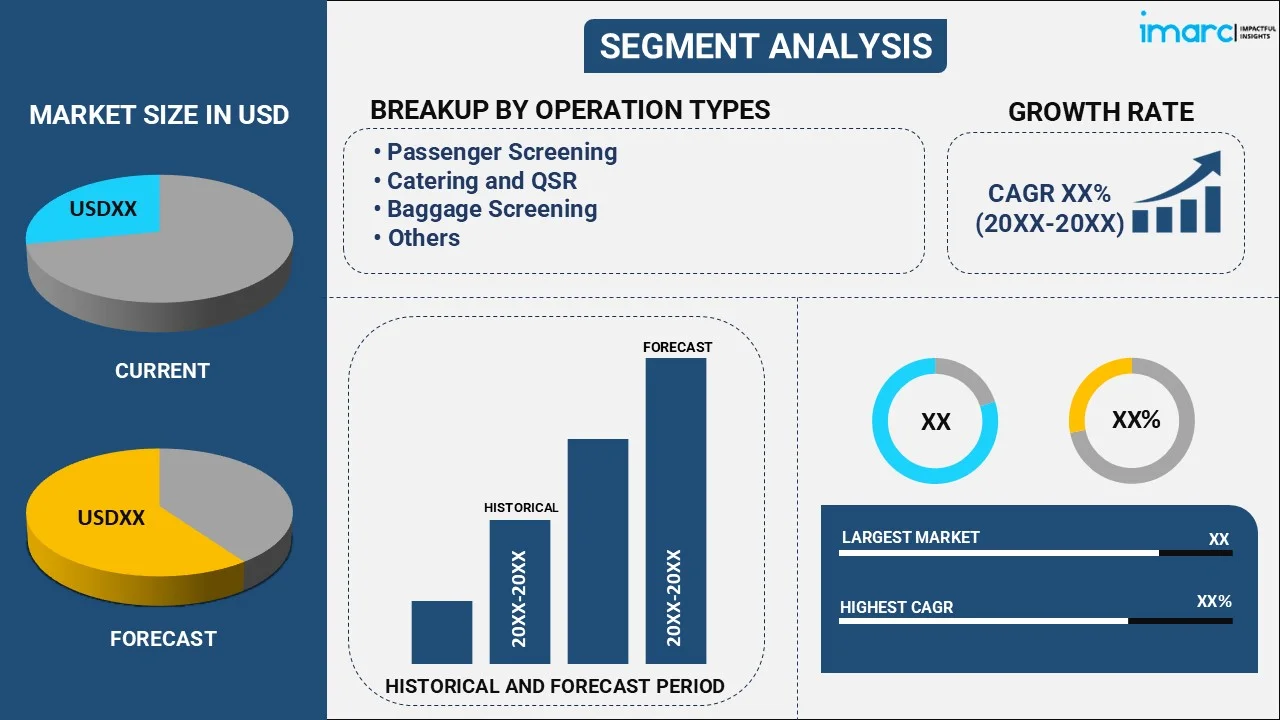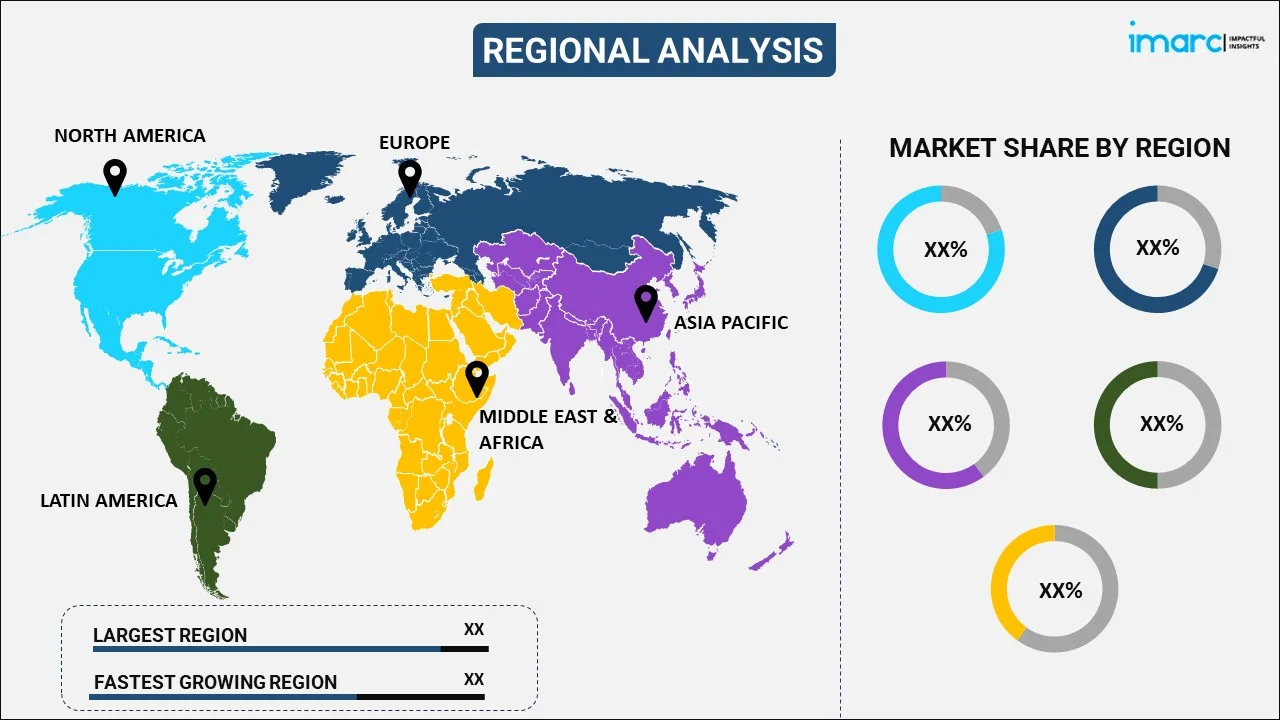
Airport Terminal Operations Market Report by Operation Type (Terminal Infrastructure Maintenance and Upgrade, Passenger Screening, Catering and QSR, Baggage Screening, Aircraft MRO), Airport Category (Class A, Class B, Class C, Class D, Class E), Technology (Passenger Screening, Baggage Scanners, 5G Infrastructure, E-Kiosk, and Others), and Region 2025-2033
Global Airport Terminal Operations Market:
The global airport terminal operations market size reached USD 6.7 Billion in 2024. Looking forward, IMARC Group expects the market to reach USD 13.1 Billion by 2033, exhibiting a growth rate (CAGR) of 7.32% during 2025-2033. The rising air passenger traffic, ongoing technological advancements, the increased focus on customer experience, and the growing international tourism are primarily driving the market's growth.
|
Report Attribute
|
Key Statistics
|
|---|---|
|
Base Year
|
2024
|
|
Forecast Years
|
2025-2033
|
|
Historical Years
|
2019-2024
|
|
Market Size in 2024
|
USD 6.7 Billion |
|
Market Forecast in 2033
|
USD 13.1 Billion |
| Market Growth Rate (2025-2033) | 7.32% |
Airport Terminal Operations Market Analysis:
- Major Market Drivers: The flourishing aviation industry across the globe is creating a positive outlook for the market. In line with this, the rapid modernization of airports and increasing demand for efficient services to manage passengers, aircraft, and baggage on time due to the growing air traffic is favoring the market growth.
- Key Market Trends: The increasing demand for baggage screens to enhance efficiency, improve passenger satisfaction, and prevent airline delays is providing an impetus to market growth. In addition, the implementation of stringent regulations by several governments and airport regulatory agencies to boost security and screening infrastructure, increasing adoption of fifth-generation (5G) communication to optimize operations, and rising automation in airport management systems, are anticipated to drive the market growth.
- Competitive Landscape: Some of the prominent airport terminal operations market companies include Agilent Technologies Inc., Amadeus IT Group S.A., Beumer Group GmbH & Co. KG, C.E.I.A. SpA (Ceia Di Manneschi Giovanni & Benedetti Rosanna Sapa), Honeywell International Inc., Robert Bosch GmbH (Robert Bosch Stiftung GmbH), Siemens AG, SITA, Smiths Group plc, and TAV Technologies, among many others.
- Geographical Trends: According to the airport terminal operations market dynamics, Asia Pacific exhibits a clear dominance in the market. The rising disposable incomes, urbanization, and growing middle-class populations in the region are driving higher demand for air travel. This increased passenger traffic boosts the need for efficient and expanded airport terminal operations.
- Challenges and Opportunities: The aging infrastructure of older terminals and high noise pollution are hampering the market's growth. However, advances in automation and robotics, such as automated check-in kiosks, self-bag drop systems, and robotic baggage handling, offer opportunities to enhance operational efficiency and reduce labor costs.

Airport Terminal Operations Market Trends:
Increasing Air Travel Demand
The increasing demand for air travel is one of the major drivers of growth in the airport terminal operations market. For instance, according to Statista, in 2023, worldwide air traffic passenger demand climbed by more than 36% over the previous year, when passenger demand increased by nearly 64%. This figure is expected to rise by about 12% in 2024. With more people traveling internationally and domestically, airports are experiencing higher passenger volumes. This increased demand necessitates larger and more efficient terminal facilities to handle the influx. These factors are expected to propel the airport terminal operations market in the coming years.
Expanding Tourism Growth
Global tourism growth is a significant driver of the airport terminal operations market. For instance, according to UN Tourism, international tourism earnings reached USD 1.4 trillion in 2023, accounting for around 93% of the USD 1.5 trillion collected by destinations in 2019. As international tourism grows, airports experience a surge in passenger numbers, which directly impacts the demand for more efficient and larger terminal facilities. These factors are further positively influencing the airport terminal operations market forecast.
Technological Advancements
Innovations such as automated check-in kiosks, biometric screening, and advanced baggage handling systems enhance the passenger experience and operational efficiency. For instance, in April 2024, American Airlines unveiled a new kiosk system to help with airport check-in. American Airlines sped up the check-in process by introducing bag-tag kiosks where passengers may scan their boarding cards and print luggage tags, thereby boosting the airport terminal operations market revenue.
Global Airport Terminal Operations Industry Segmentation:
IMARC Group provides an analysis of the key trends in each segment of the global airport terminal operations market report, along with forecasts at the global, regional, and country levels from 2025-2033. Our report has categorized the market based on operation type, airport category, and technology.
Breakup by Operation Type:

- Terminal Infrastructure Maintenance and Upgrade
- Passenger Screening
- Catering and QSR
- Baggage Screening
- Aircraft MRO
Baggage screening holds the majority of the total market share
The report has provided a detailed breakup and analysis of the airport terminal operations market based on the operation type. This includes terminal infrastructure maintenance and upgrade, passenger screening, catering and QSR, baggage screening, and aircraft MRO. According to the report, baggage screening holds the majority of the total market share.
According to the airport terminal operations market outlook, baggage screening at an airport terminal is a security process designed to ensure that prohibited or dangerous items do not make it onto an aircraft. Changes in security regulations, often in response to perceived threats or incidents, can increase the demand for more rigorous baggage screening procedures. Moreover, higher passenger volumes, such as during peak travel times or busy seasons, drive the need for more screening resources to manage the increased number of bags being processed. For instance, in April 2024, BEUMER Group, a strategic partner of the FTE Baggage Innovation Working Group, unveiled SECTRO, an innovative solution for hand baggage screening at airports with partner HÖRMANN Klatt Conveyors.
Breakup by Airport Category:
- Class A
- Class B
- Class C
- Class D
- Class E
The report has provided a detailed breakup and analysis of the airport terminal operations market based on the airport category. This class A, class B, class C, class D, and class E.
According to the airport terminal operations market overview, class A handles a large volume of both domestic and international passengers. It also includes multiple terminals, numerous gates, and a wide range of services. Moreover, class B serves a significant volume of passengers but not as high as Class A. It handles a mix of domestic and international flights, often focusing more on regional and national routes. Furthermore, class C handles a smaller volume of passengers, typically focusing on domestic flights. It includes one or two terminals with essential services and amenities. Besides this, class D primarily serves local or regional travelers with lower passenger volumes. It typically features a single terminal with very basic services. Also, class E serves a small number of passengers, often with limited flight options. It has simple security measures appropriate for the low volume of passengers.
Breakup by Technology:
- Passenger Screening
- Baggage Scanners
- 5G Infrastructure
- E-Kiosk
- Others
A detailed breakup and analysis of the airport terminal operations market based on the technology has also been provided in the report. This includes passenger screening, baggage scanners, 5G infrastructure, e-kiosk, and others.
Passenger screening is a critical security measure designed to ensure that individuals boarding flights are not carrying prohibited items or potential threats. This typically involves both physical checks and the use of advanced technology. Moreover, baggage scanners are used to inspect checked luggage for prohibited or dangerous items without manually opening the bags. This is crucial for maintaining security while managing large volumes of baggage. Furthermore, baggage scanners are machines used to inspect the contents of luggage and other bags. The most common type is the X-ray scanner, which provides a visual image of the items inside a bag, allowing security personnel to identify suspicious or prohibited items without opening the bag.
Breakup by Region:

- North America
- United States
- Canada
- Asia-Pacific
- China
- Japan
- India
- South Korea
- Australia
- Indonesia
- Others
- Europe
- Germany
- France
- United Kingdom
- Italy
- Spain
- Russia
- Others
- Latin America
- Brazil
- Mexico
- Others
- Middle East and Africa
Asia-Pacific currently dominates the global market
The report has also provided a comprehensive analysis of all the major regional markets, which include North America (the United States and Canada); Europe (Germany, France, the United Kingdom, Italy, Spain, Russia and others); Asia Pacific (China, Japan, India, South Korea, Australia, Indonesia, and others); Latin America (Brazil, Mexico, and others); and the Middle East and Africa. According to the report, Asia-Pacific currently dominates the global market.
According to the airport terminal operations market statistics, rapid economic growth, the rising disposable incomes, and a burgeoning middle class in countries like China and India are driving up the demand for air travel. This increase in passenger volumes necessitates expanded and improved terminal operations to handle the growing traffic efficiently. Moreover, many Asia-Pacific countries are investing heavily in upgrading and expanding their airport infrastructure. New terminal constructions, expansions of existing facilities, and modernization projects aim to enhance passenger experience and operational efficiency. For instance, in August 2024, the Union Cabinet approved the construction of a second airport in Patna, which will be created as a civil enclave at the Indian Air Force (IAF) base in Bihta, for a cost of Rs 1,413 crore.
Competitive Landscape:
The market research report has provided a comprehensive analysis of the competitive landscape. Detailed profiles of all major market companies have also been provided. Some of the key players in the market include:
- Agilent Technologies Inc.
- Amadeus IT Group S.A.
- Beumer Group GmbH & Co. KG
- C.E.I.A. SpA (Ceia Di Manneschi Giovanni & Benedetti Rosanna Sapa)
- Honeywell International Inc.
- Robert Bosch GmbH (Robert Bosch Stiftung GmbH)
- Siemens AG
- SITA
- Smiths Group plc
- TAV Technologies
(Please note that this is only a partial list of the key players, and the complete list is provided in the report.)
Airport Terminal Operations Market Recent Developments:
- August 2024: The Union Cabinet approved the construction of a second airport in Patna, which will be created as a civil enclave at the Indian Air Force (IAF) base in Bihta, for a cost of Rs 1,413 crore.
- April 2024: BEUMER Group, a strategic partner of the FTE Baggage Innovation Working Group, unveiled SECTRO, an innovative solution for hand baggage screening at airports with partner HÖRMANN Klatt Conveyors.
- April 2024: American Airlines unveiled a new kiosk system to help with airport check-in. American Airlines sped up the check-in process by introducing bag-tag kiosks where passengers may scan their boarding cards and print luggage tags.
Airport Terminal Operations Market Report Scope:
| Report Features | Details |
|---|---|
| Base Year of the Analysis | 2024 |
| Historical Period | 2019-2024 |
| Forecast Period | 2025-2033 |
| Units | Billion USD |
| Scope of the Report | Exploration of Historical Trends and Market Outlook, Industry Catalysts and Challenges, Segment-Wise Historical and Predictive Market Assessment:
|
| Operation Types Covered | Terminal Infrastructure Maintenance and Upgrade, Passenger Screening, Catering and QSR, Baggage Screening, Aircraft MRO |
| Airport Categories Covered | Class A, Class B, Class C, Class D, Class E |
| Technologies Covered | Passenger Screening, Baggage Scanners, 5G Infrastructure, E-Kiosk, Others |
| Regions Covered | Asia Pacific, Europe, North America, Latin America, Middle East and Africa |
| Countries Covered | United States, Canada, Germany, France, United Kingdom, Italy, Spain, Russia, China, Japan, India, South Korea, Australia, Indonesia, Brazil, Mexico |
| Companies Covered | Agilent Technologies Inc., Amadeus IT Group S.A., Beumer Group GmbH & Co. KG, C.E.I.A. SpA (Ceia Di Manneschi Giovanni & Benedetti Rosanna Sapa), Honeywell International Inc., Robert Bosch GmbH (Robert Bosch Stiftung GmbH), Siemens AG, SITA, Smiths Group plc, TAV Technologies., etc. |
| Customization Scope | 10% Free Customization |
| Post-Sale Analyst Support | 10-12 Weeks |
| Delivery Format | PDF and Excel through Email (We can also provide the editable version of the report in PPT/Word format on special request) |
Key Benefits for Stakeholders:
- IMARC's report offers a comprehensive quantitative analysis of various market segments, historical and current market trends, market forecasts, and dynamics of the airport terminal operations market from 2019-2033.
- The research study provides the latest information on the market drivers, challenges, and opportunities in the global airport terminal operations market.
- The study maps the leading, as well as the fastest-growing, regional markets. It further enables stakeholders to identify the key country-level markets within each region.
- Porter's five forces analysis assists stakeholders in assessing the impact of new entrants, competitive rivalry, supplier power, buyer power, and the threat of substitution. It helps stakeholders to analyze the level of competition within the airport terminal operations industry and its attractiveness.
- The competitive landscape allows stakeholders to understand their competitive environment and provides insight into the current positions of key players in the market.
Key Questions Answered in This Report
The global airport terminal operations market was valued at USD 6.7 Billion in 2024.
We expect the global airport terminal operations market to exhibit a CAGR of 7.32% during 2025-2033.
The growing adoption of Artificial Intelligence (AI)-powered self-service kiosks and robots at airport terminals for increasing service offerings to the passengers is primarily driving the global airport terminal operations market.
The sudden outbreak of the COVID-19 pandemic had led to the implementation of stringent lockdown regulations across several nations, resulting in the temporary restrictions on intra- and inter-national travel activities, thereby negatively impacting the global market for airport terminal operations.
Based on the operation type, the global airport terminal operations market can be segmented into terminal infrastructure maintenance and upgrade, passenger screening, catering and QSR, baggage screening, and aircraft MRO. Currently, baggage screening holds the majority of the total market share.
On a regional level, the market has been classified into North America, Asia-Pacific, Europe, Latin America, and Middle East and Africa, where Asia-Pacific currently dominates the global market.
Some of the major players in the global airport terminal operations market include Agilent Technologies Inc., Amadeus IT Group S.A., Beumer Group GmbH & Co. KG, C.E.I.A. SpA (Ceia Di Manneschi Giovanni & Benedetti Rosanna Sapa), Honeywell International Inc., Robert Bosch GmbH (Robert Bosch Stiftung GmbH), Siemens AG, SITA, Smiths Group plc, and TAV Technologies.
Need more help?
- Speak to our experienced analysts for insights on the current market scenarios.
- Include additional segments and countries to customize the report as per your requirement.
- Gain an unparalleled competitive advantage in your domain by understanding how to utilize the report and positively impacting your operations and revenue.
- For further assistance, please connect with our analysts.
 Inquire Before Buying
Inquire Before Buying
 Speak to an Analyst
Speak to an Analyst
 Request Brochure
Request Brochure
 Request Customization
Request Customization




.webp)




.webp)












